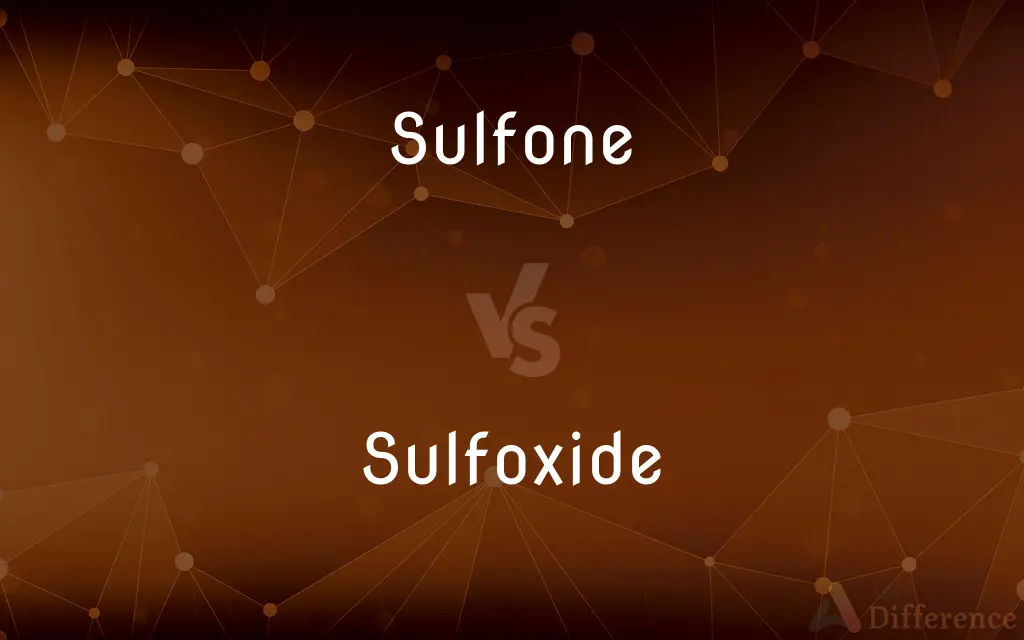Sulfone vs. Sulfoxide — What's the Difference?
Edited by Tayyaba Rehman — By Fiza Rafique — Published on April 16, 2024
Sulfone involves two oxygen atoms double-bonded to a sulfur atom, used in solvents and polymers, while sulfoxide has one oxygen atom double-bonded to sulfur, known for its solvent properties in organic synthesis.

Difference Between Sulfone and Sulfoxide
Table of Contents
ADVERTISEMENT
Key Differences
Sulfones are characterized by their sulfur atom double-bonded to two oxygen atoms, forming a part of various chemical structures used in pharmaceuticals and high-performance polymers. Sulfoxides, on the other hand, have a sulfur atom double-bonded to only one oxygen atom and are commonly used as solvents in organic reactions, highlighting their differences in chemical reactivity and applications.
The stability of sulfones under thermal and chemical conditions makes them suitable for manufacturing materials that require high durability, such as in the automotive and aerospace industries. Sulfoxides are preferred in organic synthesis due to their ability to dissolve a wide range of compounds, reflecting their unique solvent capabilities.
In terms of physical properties, sulfones often have higher boiling points and are less volatile compared to sulfoxides. This makes sulfones more useful in applications requiring materials that can withstand high temperatures without decomposing.
Sulfones are generally more resistant to oxidation than sulfoxides. This resistance to oxidation allows sulfones to be used in more demanding chemical environments, where maintaining the integrity of the chemical structure is crucial.
The synthesis of sulfones typically involves more complex chemical reactions compared to the synthesis of sulfoxides. This complexity can influence the choice of these compounds in industrial applications, where simplicity and cost-effectiveness are often key considerations.
ADVERTISEMENT
Comparison Chart
Oxygen Bonds
Two oxygen atoms double-bonded to sulfur
One oxygen atom double-bonded to sulfur
Applications
Pharmaceuticals, high-performance polymers
Organic synthesis solvents
Thermal Stability
High, suitable for materials requiring durability
Lower, preferred in temperature-sensitive synthesis
Oxidation Resistance
More resistant to oxidation
Less resistant to oxidation
Synthesis Complexity
Generally involves complex reactions
Simpler synthesis
Compare with Definitions
Sulfone
Features high chemical and thermal stability.
Sulfones are preferred in aerospace materials for their stability.
Sulfoxide
Commonly used in organic synthesis.
Sulfoxides facilitate various chemical reactions due to their solvent properties.
Sulfone
Used in high-temperature polymer applications.
Sulfone polymers are known for their exceptional heat resistance.
Sulfoxide
An organosulfur compound with one double-bonded oxygen atom to sulfur.
DMSO is a sulfoxide widely used as a solvent.
Sulfone
Resistant to oxidative degradation.
Sulfone's resistance to oxidation makes it ideal for automotive parts.
Sulfoxide
Has a distinct polarity, enhancing solubility.
The polarity of sulfoxides allows for dissolving polar and nonpolar compounds.
Sulfone
A sulfur-containing organic compound with two double-bonded oxygen atoms.
DMSO2 is a sulfone used as a solvent in various chemical reactions.
Sulfoxide
Lower thermal stability compared to sulfones.
Sulfoxides are used in reactions requiring lower temperatures.
Sulfone
Found in pharmaceuticals as sulfone antibiotics.
Sulfone antibiotics are effective against a broad spectrum of bacteria.
Sulfoxide
Can be oxidized to sulfones.
Oxidizing a sulfoxide can produce a sulfone, useful in synthesis pathways.
Sulfone
Any of various organic sulfur compounds having a sulfonyl group attached to two carbon atoms.
Sulfoxide
Any of various organic compounds that contain a sulfinyl group.
Sulfone
(organic chemistry) Any of a class of organic compounds that have a sulfonyl functional group attached to two carbon atoms; drugs of this structure have been used to treat leprosy.
Sulfoxide
A sweet-smelling viscous yellow oil, C18H28O3S, used as a synergistic insecticide.
Sulfoxide
(organic chemistry) Any compound of general formula R2S=O.
Common Curiosities
In what applications are sulfones commonly used?
Sulfones are used in pharmaceuticals, high-performance polymers, and materials requiring high thermal and chemical stability.
What defines a sulfone?
A sulfone is defined by its sulfur atom double-bonded to two oxygen atoms.
How is a sulfoxide different from a sulfone in terms of chemical structure?
A sulfoxide has a sulfur atom double-bonded to only one oxygen atom, unlike a sulfone.
Can sulfoxides dissolve both polar and nonpolar compounds?
Yes, due to their distinct polarity, sulfoxides can dissolve both polar and nonpolar compounds.
Why are sulfoxides preferred as solvents in organic synthesis?
Due to their ability to dissolve a wide range of compounds, sulfoxides are preferred for their solvent properties in organic synthesis.
How does the thermal stability of sulfones and sulfoxides compare?
Sulfones have higher thermal stability compared to sulfoxides.
What is the significance of the oxidation resistance of sulfones?
It allows sulfones to be used in environments where maintaining chemical integrity is crucial.
What makes sulfones suitable for aerospace materials?
Their high chemical and thermal stability makes them suitable for aerospace materials.
Which is more resistant to oxidation, sulfone or sulfoxide?
Sulfones are more resistant to oxidation than sulfoxides.
Can sulfoxides be converted into sulfones?
Yes, sulfoxides can be oxidized to form sulfones.
Are sulfones or sulfoxides more complex to synthesize?
Sulfones generally involve more complex synthesis compared to sulfoxides.
What role do sulfones play in pharmaceuticals?
Sulfones are used as antibiotics effective against a broad spectrum of bacteria.
How does the boiling point of sulfones compare to that of sulfoxides?
Sulfones often have higher boiling points than sulfoxides.
Why are sulfoxides used in temperature-sensitive chemical synthesis?
Their lower thermal stability makes them suitable for temperature-sensitive synthesis.
How does the solvent capability of sulfoxides benefit organic chemistry?
It enables the dissolution of a wide range of chemical compounds, facilitating various reactions in organic chemistry.
Share Your Discovery

Previous Comparison
Testing vs. Temptation
Next Comparison
Board Book vs. Hardcover BookAuthor Spotlight
Written by
Fiza RafiqueFiza Rafique is a skilled content writer at AskDifference.com, where she meticulously refines and enhances written pieces. Drawing from her vast editorial expertise, Fiza ensures clarity, accuracy, and precision in every article. Passionate about language, she continually seeks to elevate the quality of content for readers worldwide.
Edited by
Tayyaba RehmanTayyaba Rehman is a distinguished writer, currently serving as a primary contributor to askdifference.com. As a researcher in semantics and etymology, Tayyaba's passion for the complexity of languages and their distinctions has found a perfect home on the platform. Tayyaba delves into the intricacies of language, distinguishing between commonly confused words and phrases, thereby providing clarity for readers worldwide.













































